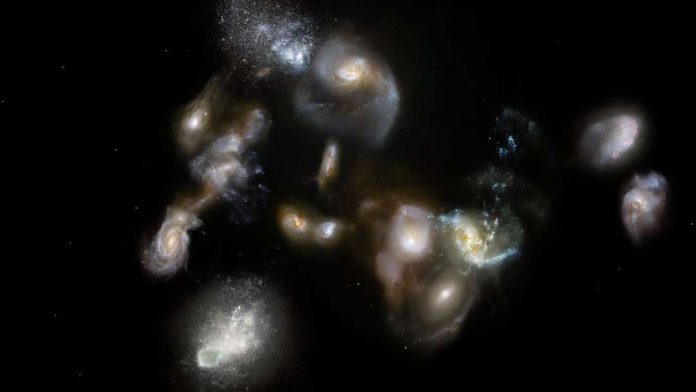Scientists spot huge, ancient collision in space that could change our understanding of the universe.
The research teams, led by Iván Oteo of the University of Edinburgh and Tim Miller of Yale University and Dalhousie University in Nova Scotia, used the Atacama Large Millimeter/submillimeter Array (ALMA) and the Atacama Pathfinder Experiment (APEX) telescopes to study the merging starburst galaxies. Both Oteo’s and Miller’s findings were published in the Astrophysical Journal.
Starburst galaxies produce stars at freakishly fast rates, popping out thousands each year, whereas the Milky Way produces roughly one per year. These galaxies were prominent after the Big Bang and are located a fair distance from Earth, with their light taking billions of years to reach us. By the time it finally does, we’re seeing these galaxies as they appeared billions of years ago.
Discovered while observing our 1.5-billion-year-old universe, the South Pole Telescope and the Herschel Space Observatory found two objects that appeared as indistinct smudges of light. Further observations by ALMA and APEX revealed them to be two extremely dense packs of galaxies, one made up of fourteen galaxies and the other made up of ten. They’re the most active regions of star formation ever witnessed in the infant universe — and the galaxies within them are on the brink of collision. These cosmic mash-ups, which were originally thought to have begun when the universe was 3 billion years old, would go on to create the cores of massive galaxy clusters.
Although these active, young galaxies were known to be combining during the early years of the universe, finding so many fusing together was unexpected.
“The lifetime of dusty starbursts is thought to be relatively short, because they consume their gas at an extraordinary rate,” said Oteo in a press release. “At any time, in any corner of the Universe, these galaxies are usually in the minority. So, finding numerous dusty starbursts shining at the same time like this is very puzzling, and something that we still need to understand.”
The number of galaxies within these groups might end up rising, too. “These discoveries by ALMA are only the tip of the iceberg. Additional observations with the APEX telescope show that the real number of star-forming galaxies is likely even three times higher. Ongoing observations with the MUSE instrument on ESO’s [Very Large Telescope] are also identifying additional galaxies,” said ESO astronomer Carlos De Breuch.
In addition to finding unexpectedly dense groups, the researchers were also surprised by the rapid growth rate of the starburst galaxies. Both computer and theoretical models predict that it should have taken much longer for them to evolve into such massive objects.
“How this assembly of galaxies got so big so fast is a mystery. It wasn’t built up gradually over billions of years, as astronomers might expect. This discovery provides a great opportunity to study how massive galaxies came together to build enormous galaxy clusters,” said Miller.
Using advanced telescopes to travel back in time allows us to track our evolution and modify the (seemingly) ever-changing timeline of the infant universe. The years following the Big Bang were an exciting time for all things cosmic, and this study shows that no matter how much we think we know about the time period, there are still plenty of surprises in store.















